
午夜出版社 ——《所有》
刘港顺第三场
策展人 | 崔灿灿
开 幕 | 2018.3.03. 3:00pm
展 期 | 2018.3.03—2018.04.01
地 点 | 站台中国当代艺术机构
(北京朝阳区酒仙桥路2号798艺术区中二街D07)
刘港顺大型个展《所有》分为三个部分“观念三要素”、“历史的笔记”、“午夜出版社”。分别于2017年12月23日、2018年1月20日与2018年3月3日举行三次开幕。第三部分“午夜出版社”展期将持续至2018年4月01日。
午夜出版社
文|崔灿灿
“行星的含义当然是“漫游者”,当人们还不能理解它们的运动规律性,而认为他们应该是在天空随意漫游的时候,人们赋予了这一名称。”
--E·H·卡尔《历史是什么?》
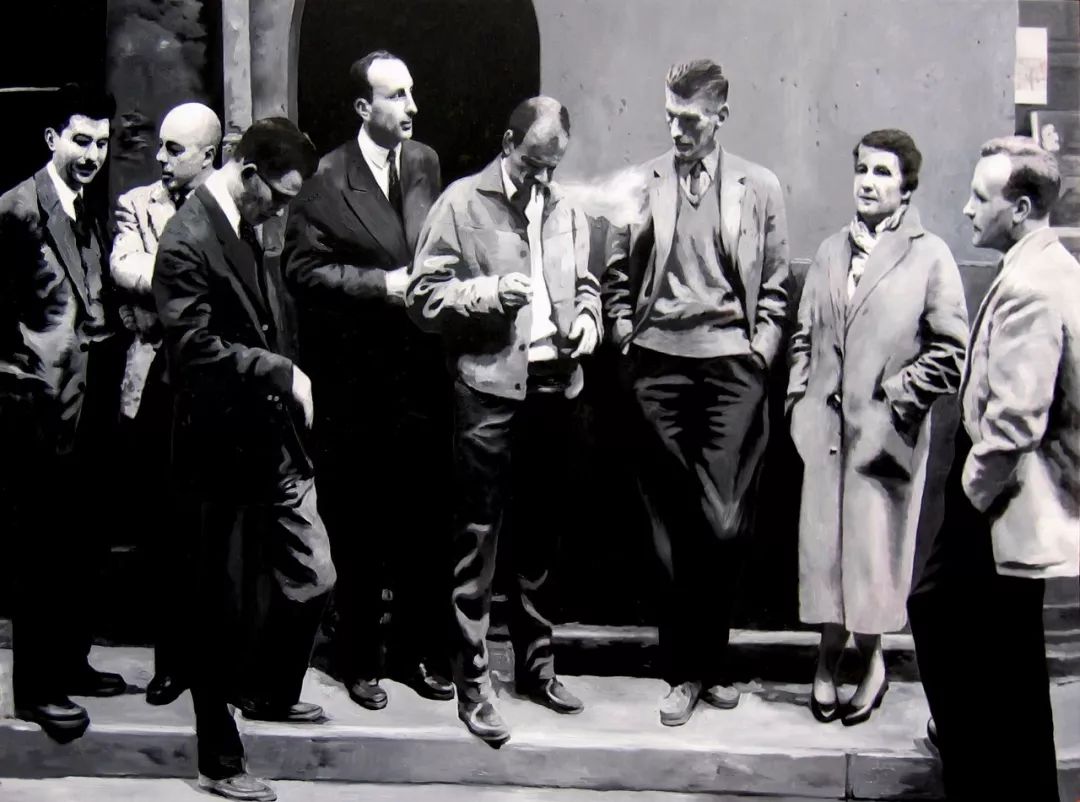
新小说作家 | New Novel Writer
2005 | 布面油画 oil on canvas | 147.5x198cm
午夜出版社在巴黎的一栋阁楼里,只有一条向上的狭窄楼梯。最初的社员不过10人,每年出版的品种不足50种,在法国五千余家出版社中再平凡不过。就是这样一家再普通不过的出版社,出版了莫里亚克、格里耶、贝克特、西蒙、杜拉斯、潘热、布托等法国新小说的代表书籍,风靡世界,像是璀璨的繁星点亮了整个星空。
1995年,刘港顺在湖北黄石开办了一家独立书店“后人类书店”。在此之前,法国新小说主张摆脱旧的道德观念和思想情感,打破时空结构和叙述顺序的限制,采用了意识流和虚实交错、时空颠倒等手法来描绘作家的内心世界。这个突如其来的语言世界,对1980年代以来的中国文学产生了很大的影响,成为80年代文化热的标志之一。在那之后的十多年中,出现了许多由知识分子和艺术家创办的书店,如北京万圣书园、广州博尔赫斯书店、成都卡夫卡书店,贵州西西弗斯书店等。此后,在中国,再也没有哪个年份,或是哪种浪潮,可以对读书有那般清澈的理想。
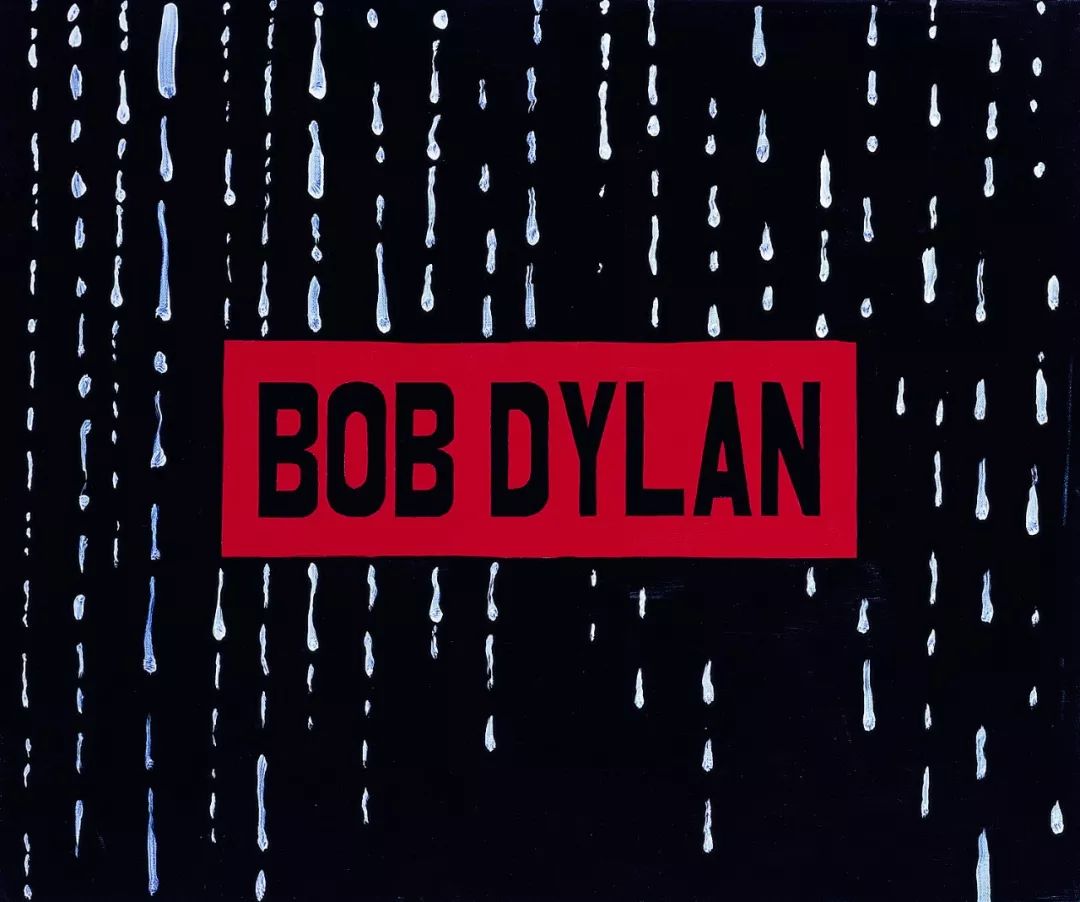
鲍勃.迪伦| Bob Dylan
2006 | 布面丙烯 acrylic on canvas | 50x60cm
80年代的文化热潮,经历了90年代的消费主义之后,终在世纪末退去。2005年,刘港顺创作了一张名为《镜子》的作品,四位新小说作家的合影被布朗的8.7公分原则分割,人物在条形背后若隐若现,似有似无。
我们由此开始,重返刘港顺画面里的历史记忆,杜尚送给妹妹苏珊婚礼的一本几何书,被挂在阳台,任凭风吹日晒,如影随形,作品名为《要幸福》。在英国电影资料馆里,吉尔伯特和乔治的一次偶发行为,一个语焉不详的偶然性瞬间。维特根斯坦的侧面头像,如青铜浮雕,刻画在80年代哲学人的脑海中。黑底白线像随风而逝的雨滴,那是一张鲍勃·迪伦的唱片封面,与音乐一起,在风中飘荡。这些时代的记忆,在何时消失,我们并不得知,但当它被唤起时,它所激发的不仅是过往,也是我们重新审视自己的契机。它的回声亦如潜入人心的乡愁,活在我们的意识之中,直到变成我们的眼神与举止的一部分,无名状的和自身不可分离。
80年代是一个普遍文化启蒙的开端,历史由所有人分享,但它无法满足对于自我和创造的渴望。刘港顺开始各种尝试,表现主义绘画、拼接艺术、现成品装置。他像那个年代的绝大多数艺术家一样,努力的参与运动,积极的吸取新知识,每日每夜聊着晦涩的学术,创造永远无法满足渴望。对观念艺术的偏爱,在那时就初见端倪,他从黄石出发,带着资料,拜访黄永砯、吴山专。他迫切的需要交流,渴望世界的曲调与和弦。直到用一根绳子穿过一吨书之后,强烈的概念意识一而再,再而三的反复确认:《卫生卷筒的使用说明》,一篇新绘画的宣言,一本打不开的回忆录,一个颜料盒的商标。至此,关于绘画与真实、绘画与修辞、能指与可指的道路,逐渐开启。

卫生卷筒使用说明| Roll Toilet Paper Instruction
1993 | 综合材料 mixed media | 30x32cmx4
“我们都过着口是心非的生活”,刘港顺颇为喜欢作家米勒的这句话。2002年,由于经营不善,刘港顺关掉了书店,来到北京。此后,他一直生活在宋庄,现实空间的变化使得刘港顺少了最初参与运动的热情,独立少见的创作方式,也让他很难获得世俗意义上的成功。但对于刘港顺来说,这些似乎都不是太大的问题,未来只是幽灵,并没有太多设想的余地。他以一种离群索居的方式,为自己造了一座“塔”,他在这座塔里读书,研究他人、过去、现在和幽灵般的未来,正如人们从塔里研究星辰。他在约翰斯的《四季》里找到人生的隐喻,相比眼花缭乱的世界,这张画的图像来源如此神秘。
艺术总是斡旋在我们的幸运和失望之间,梦幻是完好无损的永恒王国。刘港顺平静或是平淡、朴实的生活,并不能抵挡现实的侵扰。在中国,没有人完全可以退回个人生活。作品《1984》里一个小便池和无水的洗手池,在幽闭的空间中,像是同名小说里一样的压抑和幽闭。这样的情绪让他感到限制,但他更愿意把现实境遇作为一种诱发的情绪,对作品有建设性指涉的态势。他画了一批作品,指向不同情景和概念的空间,有自己的工作室、某处虚构的展厅,宋庄的北塘、建筑师的工作间、重组的蒙德里安的书架和霍克尼的加州泳池。有些画面上写道:“一切权力归想象”,有些画面写道:“寻隐者不遇”。
在那些简单、零度的观念要素中,不断推近、退远的历史笔记中,或是在午夜出版社的那间阁楼里,所有关于刘港顺的评论,来源于这样一个过程:它由我所看到的资料和流传的事物造就,由事实、故事、陈述、传说、评论和个人的想象造就。我不断地描摹、创造,试图激活刘港顺的所有,但我知道这是徒劳。“所有”对于我和刘港顺都是一个企及,一个试图拥有什么,又能拥有什么,表达什么,针对什么的愿景。
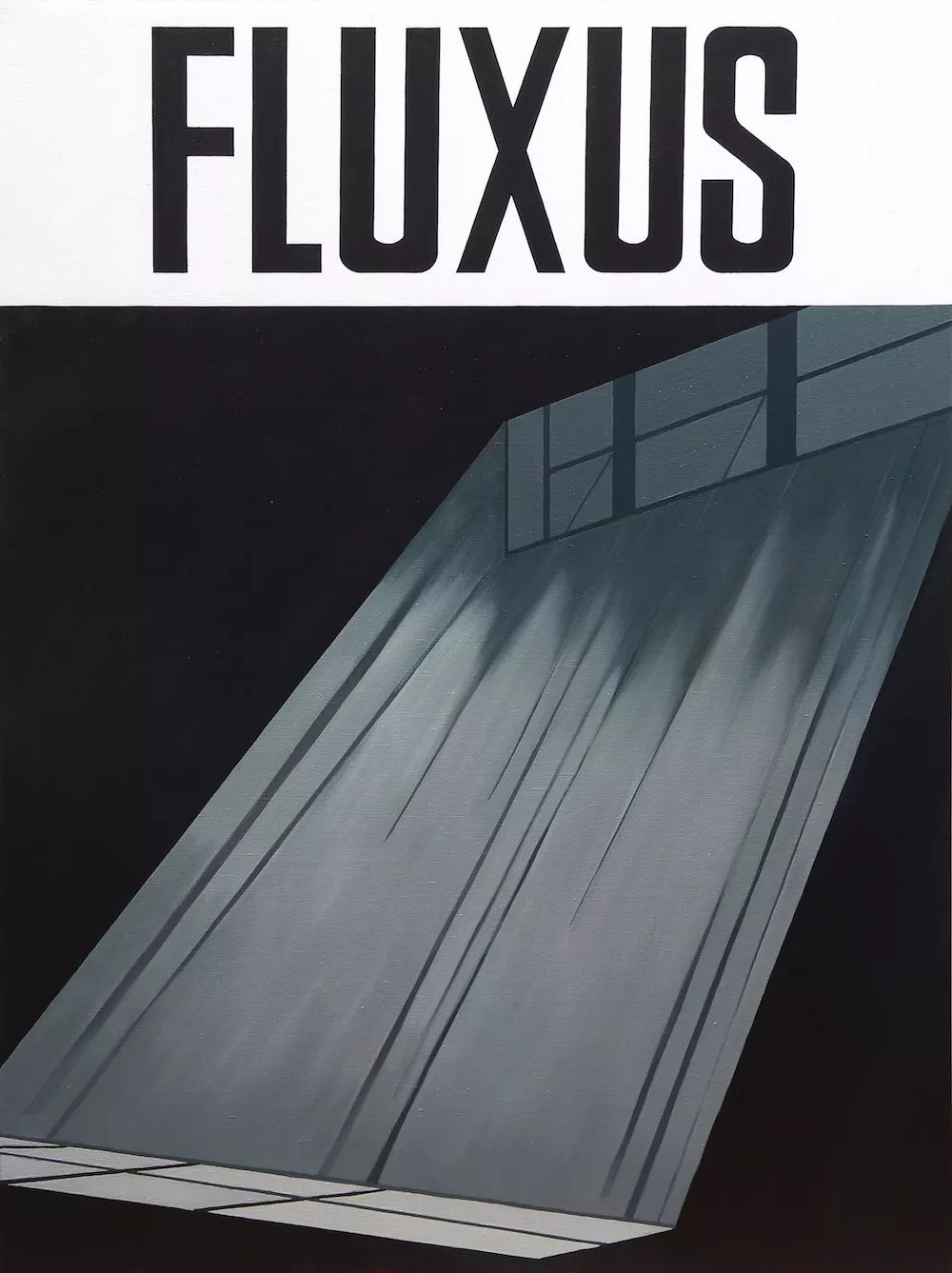
福鲁克萨斯| Fluxus
2007 | 布面油画 oil on canvas | 198x147.5cm
2007年的一张名为《福鲁克萨斯》的作品引起了我的兴趣,一个暗光厂房中,一束纪念碑式的光,像是可以穿透墙面,照在高大空旷的室内。画面上方用标语式的字体写着英文“激浪派”。在刘港顺离群索居的15年之后,为何还会有如此强烈、坚硬的浪漫情绪和运动理想?这个情绪在其近30年的创作生涯中时隐时现,有时已如隐者,有时又赫然在目。它的意义像是一个连通系列思考和行动的连接点,对于刘港顺意义攸关,像是午夜出版社,试图以理想的繁星点亮整个星空的初衷。
两年之后,刘港顺画了一张名为《日日夜夜》的作品,他在介绍里写道:“画里隐隐约约的街,和画面上既是月亮,又是太阳的圆,遥相辉映。日日夜夜更多的是一种精神的不眠之夜。”
刘港顺
1963年生于湖北黄石,现工作生活于北京。主要个展包括《所有一一刘港顺》站台中国(2017)、《超文本》荔空间(2016)、《静水流深》卓越艺术空间(2014)、《刘港顺》子桐画廊(2014)、《耽搁》宋庄美术馆(2012)、《刘港顺作品展》黄石文化宫(1988)。主要群展包括《丛林 III 一一 寻常》站台中国(2017)、《中国当代》卢森堡迪基希市美术馆(2016)、《1964一2014法中相知相交五十载:五十位中国当代艺术家作品巴黎邀请展》巴黎17区市政厅(2014)、《回顾与展望1920一2011》湖北美术馆(2011)、《行为艺术中国文献1985一2010》宋庄美术馆(2010)、《改造历史2000一2009年的中国新艺术》国家会议中心(2010)、《中国第三回文献展》上海(1994)、《首届九十年代艺术双年展》广州(1992)、《湖北省青年艺术节》武汉(1985)。
崔灿灿
是一名活跃在中国的独立策划人,曾获CCAA中国当代艺术评论青年荣誉奖,《YISHU》中国当代艺术批评奖等,策划的主要展览包括夜走黑桥(2013)、乡村洗剪吹(2013)、FUCKOFF II (2013)、不在图像中行动(2014)、六环比五环多一环(2015)、十夜(2016)等,曾策划的艺术家个展包括艾未未、夏小万、沈少民、王庆松、何云昌、萧昱、琴嘎、谢南星、史金淞、李占洋、许仲敏、马轲、夏星、赵赵、秦琦、李青、陈彧凡、陈彧君、厉槟源、冯琳、张玥、宗宁、姜波、牧儿等。
Midnight Press -- ALL
III Part of Liu Gangshun's Solo Exhibition
Written By Cui Cancan
Planet certainly implies “wanderer”. When people cannot understand their law of motion and think they should wander casually in the sky, people give them the name.
——What is History? By Edward H. Carr

镜子| Mirror
2005 | 喷绘丙烯 acrylic jet print| 147.5x198cm
Located in an attic in Paris, Midnight Press only has an upward and narrow stairway. Originally, it had less than 10 members and published less than 50 varieties each year, making it a truly ordinary press among 5,000-plus publishing houses in France. Yet, it is this truly ordinary press that published the representative books of French new novel writers, including Mauriac, Grillet, Beckett, Simon, Duras, Pinget, and Buto, among others. With popularity around the world, Midnight Press has illuminated the whole sky like dazzling stars.
Liu Gangshun opened an independent bookstore – “Post-Human Bookstore” in Huangshi, Hubei Province in 1995. Before that, French new novels had advocated casting off old moral ideas, thoughts and emotions, breaking the restrictions of space-time structure and narrative order, with the inner world of the authors being described with the stream of consciousness, co-existence of virtual world and reality, reverse of time and space, and other means. This unexpected language world has greatly impacted Chinese literature since the 1980s and become one of the marks of the cultural craze in the 1980s. Many bookstores founded by intellectuals and artists emerged in more than a decade after that, such as Wansheng Bookstore in Beijing, Borges Bookstore in Guangzhou, Kafka Bookstore in Chengdu, and Sisyphus in Guizhou, to name but a few. Since then, there hasn’t been a year or wave in China which can have such a clear ideal for reading.
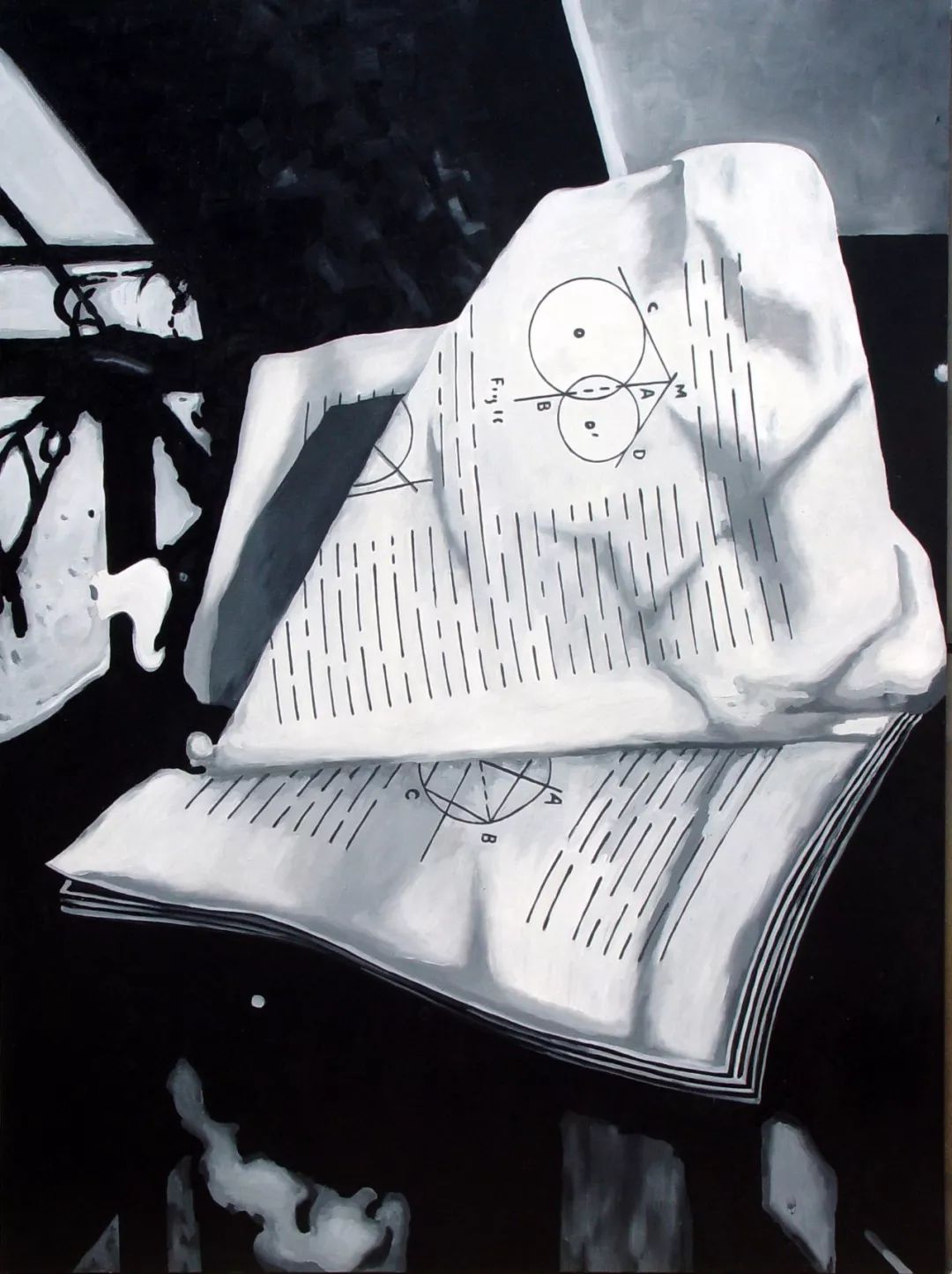
随风而逝| Gone With the Wind
2006 | 布面油画 oil on canvas | 198x147.5cm
The 1980s cultural craze finally disappeared at the end of the century after the consumerism in the 1990s. In 2005, Liu Gangshun created a work named Mirror where the group photo of four new novel writers are divided by the 8.7cm principle of Brown, and are indistinct behind the bars.
From here, we will return to the historical memory in the pictures of Liu Gangshun. A geometry book presented by Duchamp to his younger sister Susan as the wedding gift is hung on the balcony and exposed to wind and sun, like the shadow following the person – the work is named “Be Happy”. BFI National Archive witnesses an accidental behavior of Gilbert and George, and an occasional moment mentioned but vaguely. The lateral head portrait of Wittgenstein is depicted in the minds of the philosophers in the 1980s like bronze relief. Black base and white line looks like raindrop going with the wind, which is the cover of a disc of Bob Dylan, and floats in the wind with the music. We don’t know when these memories of the times disappear, but when they are aroused, they not only refresh the past, but also represent an opportunity for us to review ourselves. Its echo is living in our consciousness like nostalgia until it becomes part of our eyesight and behavior and inseparable from us unknowingly.
The 1980s is the start of common culture enlightenment. History is shared by all, but it cannot meet the aspirations for ego and creation. Liu Gangshun began to try everything from expressionist painting, mosaic art to ready-made article and device. Like most of the artists at that era, he industriously participated in movements, actively took in new knowledge, talked about obscure scholarism every day and night, yet the creation can never meet the aspirations. His preference in conceptual art began to take shape by then. He left Huangshi, took materials with him and visited Huang Yongping and Wu Shanzhuan. He was in sore need of communication, longing for the melody and chord of the world. Until "A Ton of Books Threaded by A Rope", the strong conceptual awareness was repeatedly confirmed: "Roll Toilet Paper Instruction", a declaration of a new painting, a copy of memoirs that cannot open, and a trademark in a paint box. Thus far, the road about painting and reality, drawing and rhetoric, signifier and the denotable was opened gradually.
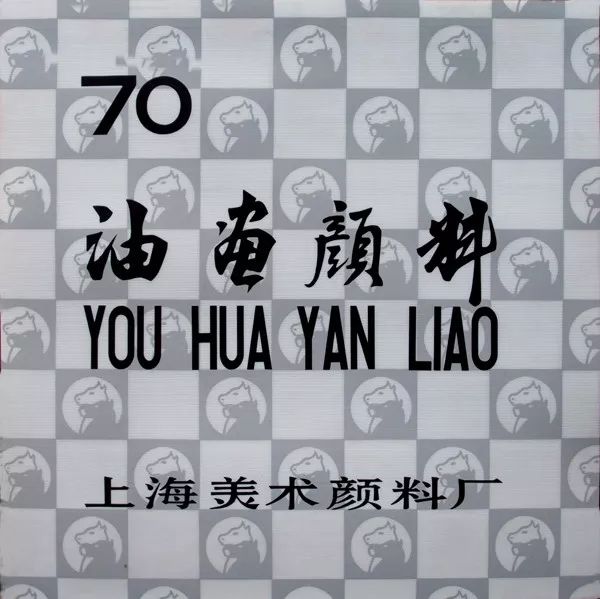
油画颜料| Oil Paint
1993 | 综合材料 mixed media | 105x105cm
“We all live a life of duplicity” , Liu Gangshun likes very much these words of the writer Miller. In 2002, Liu Gangshun closed the bookstore due to bad operation and came to Beijing. Since then, he has lived in Songzhuang and lost his previous passion for participating in movements, and the independent and rarely seen way of innovation due to the changes in real space, has made it difficult for him to succeed in the secular sense. But for Liu Gangshun, these seem not to be bigger questions. The future is nothing but ghost and there isn’t much room for imagination. He has lived in solitude and built a “pagoda” for himself whereby he has read books, studied on other people, the past, present and ghostly future just like people study on stars from the pagoda. He has found the metaphor of life from "Four Seasons" of Johns. Compared with the dazzling world, the image source of the picture is so mysterious.
Art has always mediated between our luckiness and disappointment, and dream is an intact and everlasting kingdom. The calm or insipid and unadorned life of Liu Gangshun cannot withstand the invasion of reality. In China, nobody can fully return to his personal life. The urinary and waterless hand washing sink in the work "1984" are as depressive and pent-up as in the novel of the same name in the pent-up space. Such an emotion makes him feel restricted, but he is more willing to take the realistic circumstance as a kind of inducing emotion with a constructive reference posture to the world. He has produced a batch of works, pointing to the space of different scenarios and concepts, including his studio, an imaginary exhibition room in some place, Beitang of Songzhuang, studio of architect, reorganized bookrack of Mondrian and the swimming pool of Hornik in California. Some picture reads “Every Power Turns into Imagination”, while other picture reads “After Missing the Recluse”.
Among those simple and zero conceptual elements, the historical notes constantly zooming in and out, or in the attic of Midnight Press, all comments on Liu Gangshun come from a process as such: it is formed from the materials I have seen and the widespread objects, and from the facts, stories, narrations, tales, comments and individual imaginations. I constantly portray, create, and try to activate all works of Liu Gangshun, but I know this is fruitless. For Liu Gangshun and me, “all” is a scope, and a vision of trying to own something, being able to own, express something and target at something.
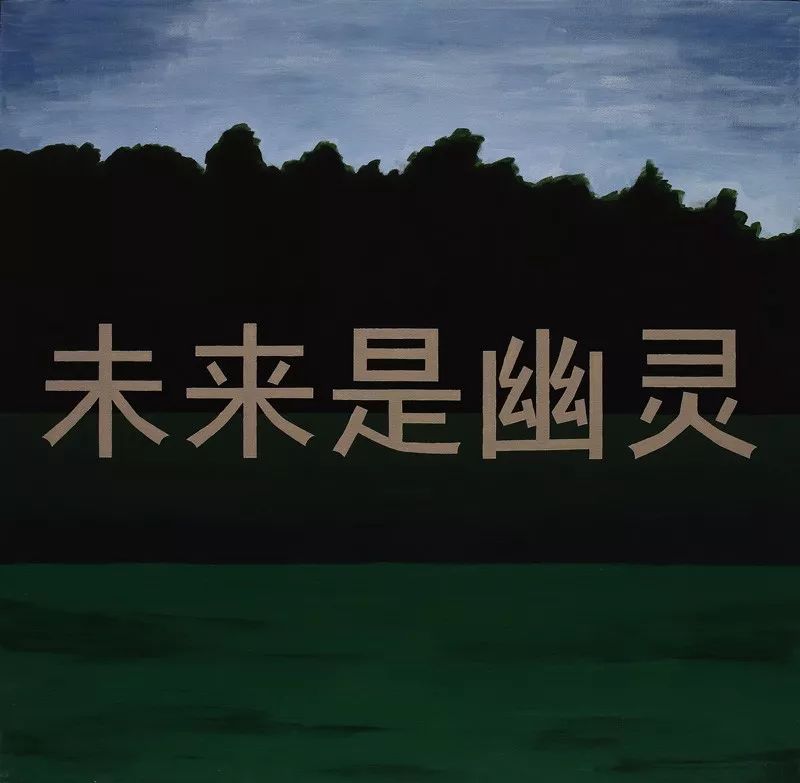
未来是幽灵| The Future Is a Ghost
2010 | 布面丙烯 acrylic on canvas| 160x160cm
A work named "Fluxus" in 2007 aroused my interest – in a dark light workshop, a monument-like light shines the high and open room as if it can penetrate through the wall space. There are slogan-type characters on the top of the picture which reads “FLUXUS” in English. Why does he still have so strong and tough romantic emotion and movement ideal 15 years after he has lived in solitude? Such an emotion is indistinct in his nearly 30 years of creation career, disappearing and impressive now and then. Like a connection that brings together series of thoughts and actions, it has a meaning critical to Liu Gangshun just like Midnight Press with the original intent of illuminating the whole sky with ideal stars.
Two years later, Liu Gangshun made the work named "Day and Night" . He said in the statement that “The faint street in the painting echoes with the circle on the picture which is both moon and sun. What’s more Day and Night points to the spiritual sleepless night.”
LIU Gangshun
Born in Huangshi, Hubei, China in 1963, Living and working in Beijing. Solo Exhibitions: “All -- Liu Gangshun” , platform China (2017); “Hypertexte”, 798 Li Space (2016); “Still Water Runs Deep”, 798 Joy Art Gallery (2016); “Liu Gangshun”, ZiTong Gallery (2014); “Delay”, Songzhuang Art Center (2012); “Liu Gangshun Art Exhibition”, Huangshi Cultural Center (1988). Group Exhibitions: “Jungle III -- Common”, Platform China (2017); “Chinese Contemporary”, Diekirch Museum (2016); “1964-2014, A time of Recognition and Friendship - Art Exhibition Featuring 50 Chinese Artists”, Paris 17 District Town Hall, France (2014); “Retrospection and Expectation 1920——2011”, Hubei Museum (2011); “The Documenta Of Chinese Performance Art 1985——2010”, Songzhuang Art Center (2010); “Reshaping History China art from 2000 to 2009”, China National Convention Center (2010); “The 3rd Exhibition of Chinese Document” Shanghai (1994); “The First 1990’s Biennial Art Fair”, GuangZhou (1992); “The Youth Art Festival of Hubei Province”, Wuhan (1985).
CUI Cancan
CUI Cancan is an active independent curator in ChIna. He was awarded the CCAA China contemporary art review youth award, “YISHU” contemporary art review award. Curated theme exhibitions including HEIQIAO Night Away(2013), Countryside Fashion(2013), FUCKOFF II (2013), Unlived By What Is Seen (2014), Between the 5th and the 6th Ring Road in Beijing(2015), Ten Night (2016), etc. Curated solo exhibitions for many artists including Ai Weiwei, Xia Xiaowan, Shen Shaomin, Wang Qingsong, He Yunchang, Xiao Yu, Xie Nanxing, Shi Jinsong, Li Zhanyang, Xu Zhongmin, Ma Ke, Xia Xing, Zhao Zhao, Qin Qi, Li Qing, Chen Yufan, Chen Yujun, Li Binyuan, Feng Lin, Zhang Yue, Zong Ning, Jiang Bo, MUer, etc.